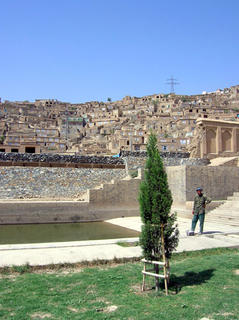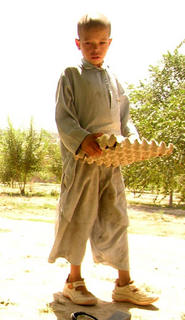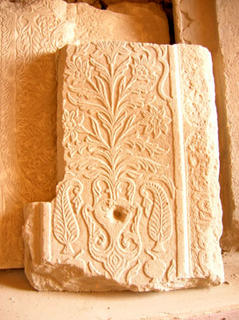A day of independence
Afghanistan celebrated a day of independence from the British on Friday – there were squares of fabric in the colours of the national flag tied to railings along the streets of Kabul, and a big celebration in the city stadium (formerly site of Taliban public executions). International organisations, meanwhile, suffered a tightening of security, and we were told to avoid ‘all unnecessary movement’ in the city. We contented ourselves with planning a trip out of town for the next two days, and booked a car to take a little group of us to Panjshir, birthplace of Ahmad Shah Massoud. That trip, however, was not to be, again due to vague reports of security concerns, whose source could not be ascertained - “sometimes we cannot disclose where our information comes from. We receive it on a need-to-know basis” we were told by an unusually nervy, conspiracy theorist staff member.
After downscaling our requests somewhat until we were asking where, other than the confines of the guesthouse, would it be acceptable for us to spend the day, we received permission to be driven to the Bagh-i Babur, or Babur’s Garden.
This, once the largest green public space in the city, was laid out as a palace and garden complex by the rulers of the Mughal dynasty, but suffered huge damage during the Soviet/ rival warlords/ Taliban eras. The garden found itself on the shifting front line between rival factions, and came under heavy mortar and rocket fire which gutted the buildings and levelled the perimeter wall. The irrigation system was destroyed, the plants withered, and the trees cut down for firewood by the desperately poor Kabulis massed in earth brick homes on the surrounding slopes.

Luckily, the Aga Khan trust for culture has been carrying out extensive research and reconstruction on the site since 2002, and the Bagh-i Babur is once again emerging as an oasis of calm and beauty in the midst of a densely populated, depressed urban area.
Entrance costs 5 afghani, or 10 US cents, for Afghans, and 20 times as much for foreigners, which seems reasonable – although we did try to persuade the guards to give the Tajik lady who was with us a discount, to no avail.
The garden is a hive of activity, as over 150 gardeners, builders and skilled craftsmen beaver away across the site to get everything finished in time for a grand opening scheduled for next spring, but it is also a very peaceful place.
Everything that day was suffused in a rosy haze of delight at having evaded our gaolers in the security department, and the grass of the Bagh-i Babur seemed to us incomparably greener than that of our lovingly tended guesthouse garden.
We had brought a carpet, two melons and three flaps of hot bread, and we spread ourselves out on a grassy terrace under a fruit tree. The garden is terraced, and the 700 newly planted trees are watered by little channels that bring water down from a large stone pool at the highest level. Soon, a series of fountains and pools built along the central axis of the garden will be completed – at the bottom, a visitors’ centre will be housed in a traditional earthen dome building going up on the site of an old caravanserai.
From our quiet, cool vantage point under the tree, we could see the teams working on the restoration of the haremserai complex, and watch gardeners sprinkling the lawns with the aid of a spade. Everyone we encountered was friendly, proud of their work and keen to show us round.
Soon after we had arrived, a little boy turned up wanting to sell us hard boiled eggs. We bought eight eggs from him in the course of the day, shared our melon with him and asked him questions. He was a pitiful sight, with light coloured eyes, broken teeth and a pockmarked, scared face, a child so damaged-looking it is hard to imagine him reaching adulthood, somehow.

His eyes avoided ours as he answered our questions, and told us he did go to school, and was 6th in his class of over 35. He lives with his mother and siblings, his father is somehow unable to work. He buys his boiled eggs for 3.5 Afg, and sells them for 5 Afg, so that in a good day he makes a dollar. He did not invite pity or even sympathy from us, wandering off in the midst of our questions, to return a little while later and sit under the shadow of a neighbouring tree.
Some drunken men in uniform came up and asked us for whisky, and retreated when we offered them water, scattering plastic cups and other rubbish about them. In a flash of anger I upbraided them for fouling such a beautiful place with their rubbish, and threw their rubbish after them. All of Kabul is awash with trash, and in general people demonstrate a cavalier disregard for cleanliness, order and the natural habitat outside their own homes. Surprisingly, in retrospect, the men in uniform reacted good-naturedly, apologised for being ‘a little crazy’, and ordered the little egg boy to collect all their rubbish.

The rest of the day passed peacefully – the high point was being shown round the haremserai, where some lovely carved tombstones have been discovered, and the greenhouse, where I met a flock of ladies, with their billowing blue burqas lifted up over their faces. I fell into conversation with one, and it made my heart skip to do so, as the women of Afghanistan have seemed so remote and unapproachable to me, forever inscrutable under their burqas or invisible behind the walls of their homes.
It turns out these women are from Mazar, and had come to Kabul only for a few days, for a family wedding, so I will be able to visit them again once we return north.

0 Comments:
Post a Comment
<< Home